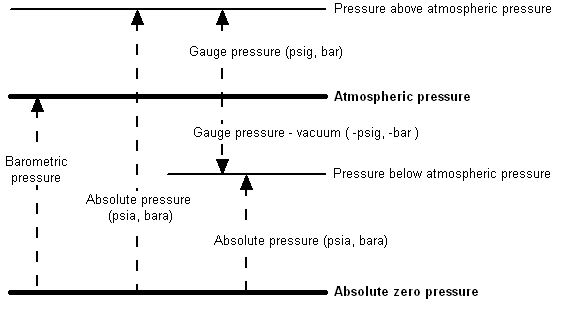Introduction to Pressure relationship psi Mpa Kpa Bar
The pressure in a fluid is defined as
“The normal force per unit area exerted on a imaginary or real plane surface in a fluid or a gas”
The equation for pressure can expressed as:
p = F / A (1)
where
p = pressure [lb/in2 (psi) or lb/ft2 (psf), N/m2 or kg/ms2 (Pa)]
F = force [1), N]
A = area [in2 or ft2, m2]
1) In the English Engineering System special care must be taken for the force unit. The basic unit for mass is the pound mass (lbm) and the unit for the force is the pound (lb) or pound force (lbf).

Absolute Pressure
The absolute pressure - pabs – is measured relative to the absolute zero pressure – the pressure that would occur at absolute vacuum. All calculation involving the gas laws requires pressure (and temperature) to be in absolute units.
Gauge Pressure
A gauge is often used to measure the pressure difference between a system and the surrounding atmosphere. This pressure is often called the gauge pressure and can be expressed as
pg = ps – patm (2)
where
pg = gauge pressure
ps = system pressure
patm = atmospheric pressure
Atmospheric Pressure
Atmospheric pressure is pressure in the surrounding air at – or “close” to – the surface of the earth. The atmospheric pressure vary with temperature and altitude above sea level.
Standard Atmospheric Pressure
Standard Atmospheric Pressure (atm) is used as a reference for gas densities and volumes. The Standard Atmospheric Pressure is defined at sea-level at 273oK (0oC) and is 1.01325 bar or 101325 Pa (absolute). The temperature of 293oK (20oC)is also used.
In imperial units the Standard Atmospheric Pressure is 14.696 psi.
- 1 atm = 1.01325 bar = 101.3 kPa = 14.696 psi (lbf/in2)= 760 mmHg =10.33 mH2O = 760 torr = 29.92 inHg = 1013 mbar = 1.0332 kgf/cm2 = 33.90 ftH2O
Pressure Units
Since 1 Pa is a small pressure unit, the unit hectoPascal (hPa) is widely used, especially in meteorology. The unit kiloPascal (kPa) is commonly used design of technical applications like HVAC systems, piping systems and similar.
- 1 hectoPascal = 100 Pascal = 1 millibar
- 1 kiloPascal = 1000 Pascal
Some Pressure Levels
- 10 Pa – the pressure below 1 mm of water
- 1 kPa – approximately the pressure exerted by a 10 g of mass on a 1 cm2 area
- 10 kPa – the pressure below 1 m of water, or the drop in air pressure when moving from sea level to 1000 m elevation
- 10 MPa – nozzle pressure in a “high pressure” washer
- 10 GPa – pressure enough to form diamonds
Some Alternative Units of Pressure
- 1 bar – 100,000 Pa
- 1 millibar – 100 Pa
- 1 atmosphere – 101,325 Pa
- 1 mm Hg – 133 Pa
- 1 inch Hg – 3,386 Pa
A torr (torr) is named after Torricelli and is the pressure produced by a column of mercury 1 mm high – equals to 1 / 760th of an atmosphere.
- 1 atm = 760 torr = 14.696 psi
Pounds per square inch (psi) was common in U.K. but has now been replaced in almost every country except in the U.S. by the SI units. Since atmospheric pressure is 14.696 psi – a column of air on a area of one square inch area from the Earth’s surface to the space – weights 14.696 pounds.
The bar (bar) is common in the industry. One bar is 100,000 Pa, and for most practical purposes can be approximated to one atmosphere even if
1 Bar = 0.9869 atm
There are 1,000 millibar (mbar) in one bar, a unit common in meteorology.
1 millibar = 0.001 bar = 0.750 torr = 100 Pa
|
